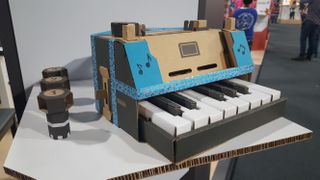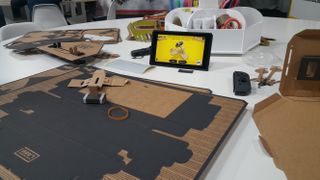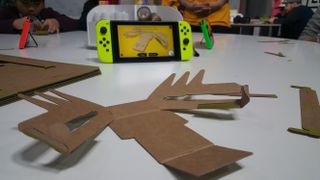[Update: We've updated our Nintendo Labo hands on review to include some footage of the Toy-Con garage feature that's been recently released by Nintendo. Though we were able to see this feature in action at the event we attended, we weren't allowed to capture any footage of it. Now you can see this interesting and innovative aspect of Labo for yourself below.]
Announced earlier this year, Nintendo Labo is a new peripheral for the Nintendo Switch which involves constructing a variety of controllers (known as Toy-Cons) from cardboard and combining them with the console’s Joy-Cons to play games.
Remember on the mornings of your birthday or Christmas when your parents would despair as you threw aside expensive presents in favor of getting inside their boxes? That’s the side of you that Nintendo is trying to reach. ‘For kids and those who are kids at heart’ the announcement stated.
Now, if we’re totally honest we don’t really see ourselves as kids at heart any more. We’re not saying if you opened us up you’d find a weakly beating misanthropic raisin, but the childish sense of wonder and imagination that had us clambering into empty boxes and turning them into rocket ships is thoroughly out of practice.

Nintendo encourages Toy-Con customization
It’s to Labo’s credit, then, that we had a lot of fun with it. Everything about the Labo demo we attended encouraged a feeling of excitable discovery – from the science museum setting, to the school desk-style demo stations equipped with stickers, glue and all manner of coloring pens.
It’s pretty clear at this point that Nintendo is letting the Xboxes and PlayStations of the world chase the best graphics and the the most powerful components. There’s no point in the Switch creator trying to compete there anymore. Instead Nintendo is setting itself apart by focusing on something very simple – fun and play.
With the Switch we have a console that attempts to remove any and all barriers to play. With Labo we have an accessory that uses this hardware to show that fun is more than good graphics and tight mechanics – it’s also our own creativity and imagination.
How does it work?
Labo uses some pretty simple technology in an innovative way. On the right Joy-Con of the Nintendo Switch there’s an infrared sensor and on each Toy-Con construction there are selectively placed infrared stickers. Working together with the motion controls within the Joy-Cons, the infrared sensor and stickers communicate and allow you to use the Toy-Cons to interact with one another or what’s happening on the Nintendo Switch screen.
When you start it up, you’ll find Nintendo Labo has three sections: Make, Play, and Discover. The Make section contains all of the instructional guides for putting together your Toy-Cons; Play is the place where you’ll find all of the relevant mini games (each Toy-Con has at least one); and Discover is the place where you can find out more about how the Toy-Cons work and what you can do with them. It’s also the place where you’ll find the Toy-Con Garage, but we’ll come back to that later.
Ease of use
Each of the Nintendo Labo Toy-Cons are DIY – it’s like IKEA for fun as opposed to dull function. The first thing we built was the fairly simple RC car, which took around ten to 15 minutes. After you’ve opened up the Nintendo Labo app on your Switch console and selected what you’re putting together, the construction instructions will appear on screen.
Fortunately, this isn’t a ‘Homer Simpson building a barbecue’ scenario – the instructions are very easy to follow and the Labo app clearly lays out which pieces you need, how to fold them, how to bring them together and how long the process is likely to take.
If you can’t quite figure something out, it’s possible to move an on-screen 3D model using the Switch’s touch screen in order to see it from different angles, as well as fast-forward and rewind the instructions. Sometimes we found the instructions were a little too helpful and we found ourselves fast-forwarding through large chunks. When three piano keys are identical, we'd rather not be told how to put them together three separate times.

The cardboard sheets can look overwhelming at first
When your Toy-Con is constructed, you simply slide the Joy-Cons into it as directed. It’s actually surprising how secure they feel in the cardboard and we weren’t worried about them slipping out and crashing to the floor.
Advertisement
Construction complexity and time varies from Toy-Con to Toy-Con. Before you start building you can see an estimate of how long the project is likely to take so you can be sure you have enough time for what you’re taking on.
Nintendo correctly estimated ten to 15 minutes for the RC car. The fishing rod, on the other hand, could take as long as two and a half hours. We tried putting together the piano Toy-Con with the help of a partner and it took us just over an hour to construct the main body.
The Robot Kit looks like a day-long challenge to us. How long before we start to see speed-runs of Nintendo Labo constructions?
Nintendo also encourages customization of Toy-Cons, and, honestly, we could have spent hours on this alone. Using colored pens, markers, tape, glue and googly eyes of all sizes it’s possible to turn your simple RC car into anything you please.

An RC car in the early stages of construction
Nintendo Labo games
Nintendo Labo offers a range of experiences and we got to try out everything within the Labo Variety pack, which included the RC car, the fishing rod, the doll house, the motorbike, and the piano.
It’s actually quite difficult to choose a favorite Toy-Con experience because they all feel very distinct and worthwhile in their own ways. The fishing rod, while repetitive, is exceptionally addictive. But we probably spent the longest amount of time with the doll house as a result of its mix-and-match accessories, which opened up several mini games. The fact that there’s an adorable creature living in the house that you get to play with and feed jelly beans also helped.
Labo’s experiences feel much more like mobile games than console games in terms of depth and appearance, but given that the construction of the Toy-Cons is clearly a big part of the fun, we don’t think this is to its detriment.
Advertisement
Each Toy-Con has its own experience, though it’s worth noting that the fishing rod and the piano have additional experiences. The fishing rod also has an aquarium game, where you can see and feed the fish you’ve caught in the main game, as well as use the piano Toy-Con to create your very own fish. The piano also has a live studio game, which allows you to play music and record it to share.
Though the games are simple, they’re afforded an unprecedented level of wonder and engagement thanks to the unique nature of their controls. It’s hard not to get a kick out of a simple fishing game when you’re using a functioning cardboard rod that was built by your very own hands. They also work seamlessly - there’s no delay between your movements and what happens on screen, and we were impressed by just how smooth everything is.
It’s refreshing to see the Joy-Con’s much-hyped HD Rumble feature get so much use after the flash in the pan that was 1-2 Switch. It offers key in-game feedback for the fishing rod and it’s even the driving force of the RC Cars.
As fun as the games are, though, we also got a look at something called the Toy-Con Garage. This can be found in Labo’s Discover section and it allows you to get far more creative with your Toy-Cons by reprogramming them to work in different ways.
It’s essentially a simple, and highly visual, cause-and-effect programming experience. You can decide which input you want, choose an action, and then select the output result of that action. For example, you can take the left Joy-Con as an input, decide you want shaking it to be the action, and say that will then cause the right Joy-Con to vibrate. Take a look at the feature in the official footage below:






No comments: